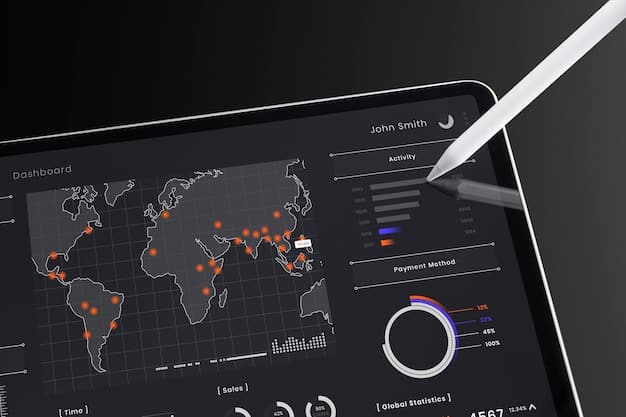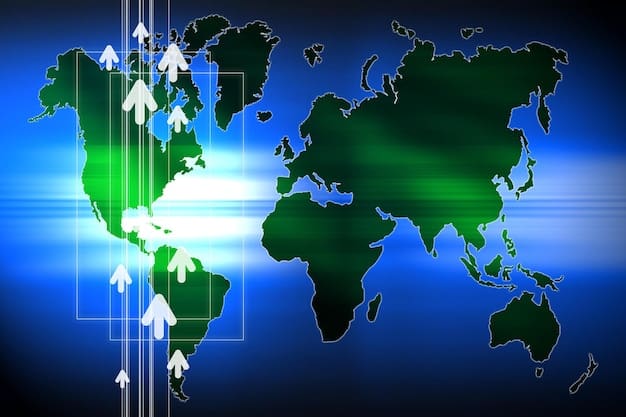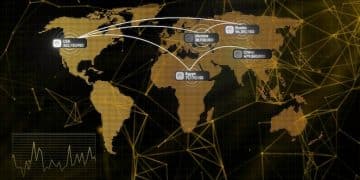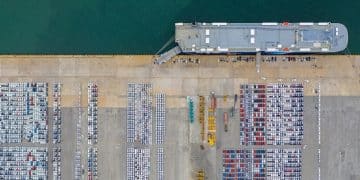US Companies: Building a Resilient Global Supply Chain for Future Disruptions

US companies can build a resilient global supply chain to withstand future disruptions by diversifying suppliers, leveraging technology for transparency, and focusing on regionalization and nearshoring strategies.
In today’s volatile global landscape, **US Companies: How to Build a Resilient Global Supply Chain to Withstand Future Disruptions Based on Recent Trends** is no longer just a competitive advantage, it’s a necessity. What steps can US businesses take to safeguard their operations?
Understanding the Evolving Global Supply Chain Landscape
The global supply chain has undergone significant transformations in recent years, driven by geopolitical tensions, economic shifts, and unforeseen events like the COVID-19 pandemic. For US companies, understanding these changes is crucial for building a resilient supply chain.
The traditional model of relying on a single source or a geographically concentrated supply base has proven to be vulnerable. Companies must now adopt a more agile and diversified approach to mitigate risks and ensure business continuity.
The Impact of Geopolitical Instability
Geopolitical instability, including trade wars and political conflicts, can significantly disrupt supply chains. Companies need to monitor global events and assess their potential impact on their operations.
The Rise of Regionalization
Regionalization involves shifting supply chains closer to home, reducing reliance on distant or politically unstable regions. This can involve nearshoring, which is relocating production to nearby countries, or reshoring, which is bringing production back to the US.
- Reduced Lead Times: Regionalization can significantly reduce lead times, allowing companies to respond more quickly to changes in demand.
- Lower Transportation Costs: Shorter distances result in lower transportation costs, improving profitability.
- Improved Communication: Closer proximity facilitates better communication and collaboration with suppliers.
- Enhanced Control: Companies have greater control over their supply chains when they are located closer to their operations.
In conclusion, understanding the evolving global supply chain landscape is paramount for US companies seeking to build resilience. By acknowledging the impact of geopolitical instability and the rise of regionalization, businesses can proactively adapt their strategies to mitigate risks and ensure operational continuity.

Diversifying Your Supplier Base
One of the most effective ways to build a resilient supply chain is to diversify your supplier base. This involves identifying multiple sources for critical components and raw materials, reducing reliance on any single supplier.
Diversification can help mitigate the impact of disruptions such as supplier bankruptcies, natural disasters, or geopolitical events. It also provides companies with greater negotiating power and flexibility.
Identifying Alternative Suppliers
The first step in diversifying your supplier base is to identify potential alternative suppliers. This involves conducting thorough market research and evaluating suppliers based on factors such as quality, reliability, and cost-effectiveness.
Building Strong Relationships
Once you have identified alternative suppliers, it is important to build strong relationships with them. This involves regular communication, collaboration, and mutual investment.
- Regular Communication: Maintain open and frequent communication with your suppliers to stay informed about their capabilities, challenges, and potential risks.
- Collaboration: Work closely with your suppliers to identify opportunities for improvement and innovation.
- Mutual Investment: Invest in your suppliers’ capabilities, providing them with the resources they need to grow and thrive.
In summary, diversifying your supplier base is a crucial strategy for US companies aiming to bolster their supply chain resilience. By actively identifying alternative suppliers and nurturing strong relationships, businesses can reduce their vulnerability to disruptions and foster greater flexibility in their operations.
Leveraging Technology for Supply Chain Visibility
Technology plays a critical role in building a resilient global supply chain. Advanced technologies such as blockchain, artificial intelligence (AI), and the Internet of Things (IoT) can provide companies with greater visibility into their supply chains, allowing them to anticipate and respond to disruptions more effectively.
Supply chain visibility refers to the ability to track and monitor the movement of goods and materials throughout the entire supply chain, from raw materials to finished products. This includes knowing where your products are at any given time, who is handling them, and what conditions they are being exposed to.
Blockchain for Transparency
Blockchain technology can provide a secure and transparent platform for tracking goods and materials throughout the supply chain. This can help companies verify the authenticity of products, prevent counterfeiting, and ensure compliance with regulations.
AI and Machine Learning for Predictive Analytics
AI and machine learning algorithms can analyze vast amounts of data to identify patterns and predict potential disruptions. This can help companies proactively mitigate risks and optimize their supply chain operations.
- Demand Forecasting: AI can improve demand forecasting accuracy, allowing companies to better plan their production and inventory levels.
- Risk Assessment: AI can identify potential risks in the supply chain, such as supplier bankruptcies or natural disasters.
- Route Optimization: AI can optimize transportation routes to minimize costs and delays.
- Inventory Management: AI can optimize inventory levels to reduce holding costs and prevent stockouts.
In conclusion, leveraging technology is indispensable for US companies striving to enhance supply chain resilience. By adopting advanced technologies such as blockchain and AI, businesses can gain unprecedented visibility into their operations, enabling them to anticipate disruptions and optimize their supply chain performance.

Exploring Regionalization and Nearshoring Opportunities
Regionalization and nearshoring are gaining popularity as strategies for building more resilient supply chains. These approaches involve shifting production closer to the US, reducing reliance on distant or politically unstable regions.
Nearshoring, in particular, offers a number of advantages for US companies, including lower transportation costs, shorter lead times, and improved communication.
Benefits of Nearshoring to Mexico
Mexico is a popular nearshoring destination for US companies due to its proximity, lower labor costs, and favorable trade agreements.
Considering Reshoring Options
Reshoring involves bringing production back to the US, which can create jobs, boost the economy, and reduce reliance on foreign suppliers.
- Increased Control: Reshoring provides companies with greater control over their production processes and supply chains.
- Shorter Lead Times: Shorter distances result in shorter lead times, allowing companies to respond more quickly to changes in demand.
- Improved Quality: Companies can maintain higher quality standards when production is located closer to their operations.
- Reduced Risk: Reshoring reduces the risk of disruptions due to geopolitical events or natural disasters.
In summary, exploring regionalization and nearshoring opportunities is a strategic imperative for US companies seeking to fortify their supply chains. By capitalizing on the advantages of proximity, reduced costs, and enhanced control, businesses can build more agile and resilient operations closer to home.
Investing in Workforce Development
A skilled workforce is essential for building a resilient global supply chain. Companies need to invest in training and development programs to ensure that their employees have the skills they need to manage complex supply chain operations.
This includes training in areas such as data analytics, supply chain management, and logistics. It also includes developing leadership skills and fostering a culture of continuous improvement.
Upskilling Your Workforce
Upskilling your workforce involves providing employees with the training and development they need to learn new skills and adapt to changing job requirements.
Attracting and Retaining Talent
Attracting and retaining talent is critical for building a strong and capable supply chain workforce. This involves offering competitive salaries and benefits, creating a positive work environment, and providing opportunities for career growth.
- Competitive Compensation: Offer competitive salaries and benefits to attract and retain top talent.
- Positive Work Environment: Create a positive and supportive work environment where employees feel valued and respected.
- Career Development Opportunities: Provide opportunities for employees to learn new skills, advance their careers, and grow within the company.
In conclusion, investing in workforce development is a fundamental requirement for US companies aiming to construct resilient global supply chains. By prioritizing upskilling initiatives and fostering a culture of continuous learning, businesses can equip their employees with the expertise needed to navigate the complexities of modern supply chain operations.
Building a Culture of Risk Management and Resilience
Building a resilient global supply chain requires a culture of risk management and resilience. This involves proactively identifying and assessing potential risks, developing contingency plans, and fostering a mindset of adaptability and continuous improvement.
Companies need to establish clear risk management policies and procedures, and they need to empower their employees to identify and report potential risks. They also need to be prepared to adapt quickly to changing circumstances and unexpected events.
Developing Contingency Plans
Contingency plans are essential for mitigating the impact of potential disruptions. These plans should outline specific steps that the company will take in the event of a disaster, such as a supplier bankruptcy, a natural disaster, or a geopolitical event.
Fostering a Mindset of Adaptability
A mindset of adaptability is critical for navigating the challenges of a dynamic global supply chain. Companies need to encourage their employees to embrace change, experiment with new ideas, and learn from their mistakes.
- Embrace Change: Encourage employees to embrace change and view it as an opportunity for growth and improvement.
- Experiment with New Ideas: Foster a culture of innovation and experimentation, where employees are encouraged to try new things and challenge the status quo.
- Learn from Mistakes: Create a safe environment where employees feel comfortable admitting mistakes and learning from them.
In summary, cultivating a culture of risk management and resilience is a critical element for US companies seeking to establish robust global supply chains. By proactively identifying potential risks, developing contingency plans, and fostering a mindset of adaptability, businesses can navigate uncertainties and ensure operational continuity.
| Key Aspect | Brief Description |
|---|---|
| 🌍 Supplier Diversification | Multiple suppliers reduce reliance on single sources. |
| ⚙️ Technology Integration | Use AI, Blockchain, for supply chain visibility. |
| 📍 Regionalization/Nearshoring | Shift production closer to the US for agility. |
| 📈 Workforce Development | Invest in training for supply chain management. |
Frequently Asked Questions (FAQ)
▼
Geopolitical instability, natural disasters, and economic fluctuations are major challenges. Managing costs while ensuring diversification and visibility also pose significant difficulties.
▼
Technology like AI, blockchain, and IoT provides real-time data, improves transparency, and enables predictive analytics, helping companies anticipate and mitigate disruptions effectively.
▼
Nearshoring is relocating business operations to nearby countries. It benefits US companies through reduced transportation costs, shorter lead times, and improved communication.
▼
A skilled workforce is crucial for managing complex supply chain operations. Training in data analytics, logistics, and risk management ensures better decision-making and adaptability.
▼
It’s a proactive strategy outlining steps to take during disruptions like supplier bankruptcies or natural disasters. Having multiple supply sources is a good first step to include in that plan.
Conclusion
Building a resilient global supply chain is an ongoing process that requires a holistic approach. By diversifying suppliers, leveraging technology, exploring regionalization, investing in workforce development, and fostering a culture of risk management, US companies can mitigate risks and ensure business continuity in an increasingly volatile world.





